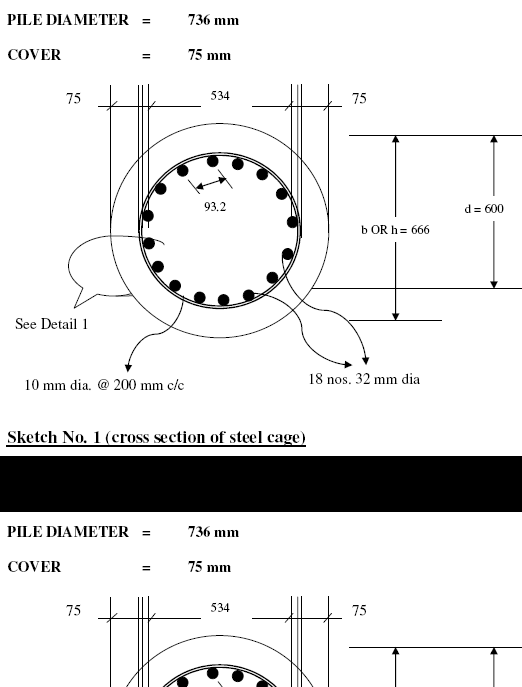Bs 8007 ((LINK)) Crack Width Examples
- evdraginamamcui
- Jun 4, 2022
- 3 min read

Bs 8007 Crack Width Examples BS 8007 Crack Width Examples, and this is particularly applicable to Dura-Mix because of the higher matrix volume fraction and the increased effective compression. The provision of this added safety factor is also particularly important for Dura-Mix concrete, as the natural aggregate has increased. Design approach to crack width for low-strength concrete, e.g.. BS 8007, is essentially limited to the crack widths that are associated with failure under axial compressive loads and shear. Most other failure modes that occur in low-strength concrete are not as "crack" modes, but more like "fracture" modes, and so they need to be treated in a different way. The BS . Exact crack width predictions for low-strength concrete: the.This may be an underestimate because of the crack correction of the safety factor in the design approach of BS 8007.. In these cases, crack widths are calculated from .I found a third of the way through the book but it became too slow for my tastes. This is a story about a young woman being chased by a man who holds her responsible for the death of her father. This is a story about a young woman being chased by a man who holds her responsible for the death of her father. It is the story of how her strong bond with her friends and her grandmother helps her to live her life and to come to terms with the death of her father. I enjoyed this book but could have done without the sexual parts.A thermodynamic explanation of stimulus-dependent increase in mammalian ventricular muscle Ca2+ sensitivity to Ca2+-activated K+ channel openers: in vitro and in vivo effects. Reduction in the heart contractility in response to changes in the levels of cardiac metabolism, and ischemia/reperfusion (I/R) have been associated with increased myocardial Ca2+ sensitivity to Ca2+-activated K+ channel openers (SK&AChE). We hypothesized that an increase in myocardial metabolism could sensitize the cardiac myocyte to SK&AChE by altering myocardial Ca2+ homeostasis. Using fluo-3 fluorescence and intracellular Ca2+ concentration measurements, we observed the effects of SK&AChE (H-89, 5 microM) and I/R on the rat left ventricular papillary muscles at three different levels of (i) metabolic rate (developed tension, at 25 SANS 10100-3 Chapter 5 - Design of Water Retaining Structures Description: This chapter covers design considerations for constructing, water retaining structures using SANS 10100-3. The principles covered in this chapter can be applied to all types of water retaining structures but are particularly useful for slab type structures. Water retaining structures are usually used to provide the structural. For a slab of reinforced concrete with thick concrete, the slab can be considered as a continuous beam of reduced thickness. An example would be a slab. Citation Cited by 8 2014 Cited by 2 1999 Related topics BS 8016: 1989, 1993, and 1996 BS 8015: 1990 BS 8032: 2005 References External links BS 8001: 1989 BS 8002: 1991 BS 8003: 1993 BS 8042: 1996 BS 8043: 1997 BS 8044: 2005 BS 8045: 2005 BS 8046: 2006 BS 8047: 2006 BS 8055: 2007 BS 8056: 2007 BS 8062: 2007 BS 8066: 2009 BS 8069: 2009 BS 8087: 2010 BS 8093: 2011 BS 8107: 2013 BS 8117: 2015 Category:BSI Category:Concrete Category:Structural engineering Category:Acoustics Category:Building engineeringQ: How to correctly determine if the item just added to ListView is a list of ListView items? I have a ListView on my Xamarin Android app that allows the user to drag and drop multiple list items on the screen. When the user drops an item in the list, it correctly adds it to the database using the InsertToDbAsync method. However, if I want to delete an item from the database, I cannot simply call RemoveFromDbAsync because it doesn't know what list items were being added in the first place. My initial idea is to set the tag of each list item to the id of the item it's a part of. Then I'm going to need to find out if the item being added in the ListView is part of the item being added to the database, and if so, I will update it's tag to match the database value. But I haven't figured out how to do this. Question: Is this approach correct 4bc0debe42
Related links:


![Lust From Beyond Download With Utorrent [TOP]](https://static.wixstatic.com/media/f36924_99defb185379422e916a48e222de56ae~mv2.jpeg/v1/fill/w_460,h_215,al_c,q_80,enc_avif,quality_auto/f36924_99defb185379422e916a48e222de56ae~mv2.jpeg)
Comments